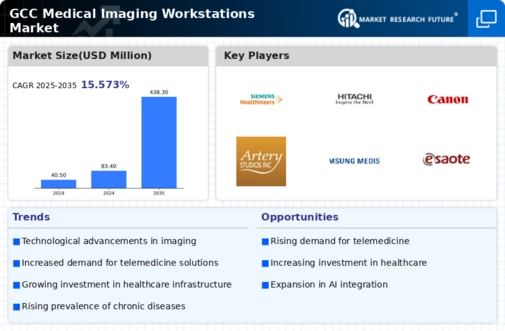The medical imaging-workstations market is characterized by a dynamic competitive landscape, driven by technological advancements and increasing demand for efficient diagnostic solutions. Key players such as Siemens Healthineers (Germany), GE Healthcare (US), and Philips Healthcare (Netherlands) are at the forefront, each adopting distinct strategies to enhance their market positioning. Siemens Healthineers (Germany) emphasizes innovation through its development of advanced imaging technologies, while GE Healthcare (US) focuses on expanding its digital health solutions. Philips Healthcare (Netherlands) is actively pursuing partnerships to integrate AI into its imaging systems, thereby enhancing diagnostic accuracy and operational efficiency. Collectively, these strategies contribute to a competitive environment that is increasingly focused on technological differentiation and customer-centric solutions.
In terms of business tactics, companies are localizing manufacturing and optimizing supply chains to enhance responsiveness to market demands. The market structure appears moderately fragmented, with several key players exerting influence over various segments. This fragmentation allows for niche players to emerge, yet the collective strength of major companies shapes the overall competitive dynamics, fostering an environment where innovation and strategic partnerships are paramount.
In October 2025, Siemens Healthineers (Germany) announced the launch of its latest imaging workstation, which integrates AI capabilities to streamline workflow and improve diagnostic precision. This strategic move is significant as it not only reinforces Siemens' commitment to innovation but also positions the company to meet the growing demand for advanced imaging solutions in the GCC region. The integration of AI is likely to enhance the user experience and operational efficiency, thereby attracting healthcare providers seeking cutting-edge technology.
In September 2025, GE Healthcare (US) unveiled a new digital platform designed to enhance interoperability among imaging devices. This initiative is crucial as it addresses the increasing need for seamless data exchange in healthcare settings. By facilitating better integration of imaging workstations with electronic health records, GE Healthcare (US) is likely to improve clinical workflows and patient outcomes, thereby solidifying its competitive edge in the market.
In August 2025, Philips Healthcare (Netherlands) entered into a strategic partnership with a leading AI firm to develop next-generation imaging solutions. This collaboration is indicative of the growing trend towards AI integration in medical imaging, which is expected to enhance diagnostic capabilities and operational efficiencies. By leveraging AI, Philips aims to differentiate its offerings and respond to the evolving needs of healthcare providers in the GCC region.
As of November 2025, the competitive trends in the medical imaging-workstations market are increasingly defined by digitalization, sustainability, and AI integration. Strategic alliances are playing a pivotal role in shaping the current landscape, enabling companies to pool resources and expertise. Looking ahead, competitive differentiation is likely to evolve from traditional price-based competition to a focus on innovation, advanced technology, and supply chain reliability. This shift underscores the importance of adaptability and forward-thinking strategies in maintaining a competitive advantage.

















Leave a Comment